Table of Contents
Indira Gandhi
Indira Gandhi was one of the most fearless and controversial Prime Ministers of independent India. The Bangladesh Liberation War that she initiated against Pakistan in 1971 was a life-changing event during her tenure as the Prime Minister. It was after this war that she became more popular among the masses. Compared with the Hindu goddess Durga, Indira Gandhi attracted accolades for her unwavering stand against Pakistan.
Born on 19th November 1917 in Prayagraj, Indira Gandhi was the daughter of Kamala Nehru and Pandit Jawaharlal Nehru, the first Prime Minister of independent India. She was the first lady Prime Minister of India and to date is the only lady Prime Minister that India has had.
Indira Gandhi served three terms as the Prime Minister of India i.e. between 1966-1971, 1971-1977, and 1980-1984. She succeeded Lal Bahadur Shastri after his untimely and suspicious death in Tashkent (Soviet Union) in 1966.
Introduction
When the partition of India took place in 1947, the new nation of Pakistan consisted of two regions. One was West Pakistan (Sindh, Punjab, and Baluchistan) and the other was East Pakistan (East Bengal). Geographically, a big chunk of Indian soil separated West and East Pakistan.
Apart from being Muslim-dominated regions, nothing was common between West Pakistan and East Pakistan. The language, culture, customs, everything was different. The power of administration was in the hands of the military, bureaucrats, and businessmen in West Pakistan. The people of East Pakistan felt isolated. There was minimal communication between the two regions. A sense of rejection slowly trickled into the people of East Pakistan.
Indira back in power and Elections in Pakistan
In 1970, a year before the Bangladesh Liberation War, the president of Pakistan, General Yahya Khan ordered fresh elections in Pakistan in December 1970. While Yahya thought he would come out victorious, he was unaware of the resentment of the people of Pakistan esp. East Pakistan. The people of East Pakistan were fed up with the arrogant and casual nature of leaders in West Pakistan and their policies towards them.
As part of the elections, Awami League, a political party in East Pakistan under the leadership of Sheikh Mujib-ur Rehman, won the majority of the seats in Pakistan and almost 99% of seats in East Pakistan. The result meant the toppling of the leadership in Pakistan and Sheikh Mujib-ur Rehman becoming the next Prime Minister. This is exactly what Yahya Khan and the leaders in West Pakistan didn’t want. The victory of the Awami League later turned out to be the primary cause of the Bangladesh Liberation War.
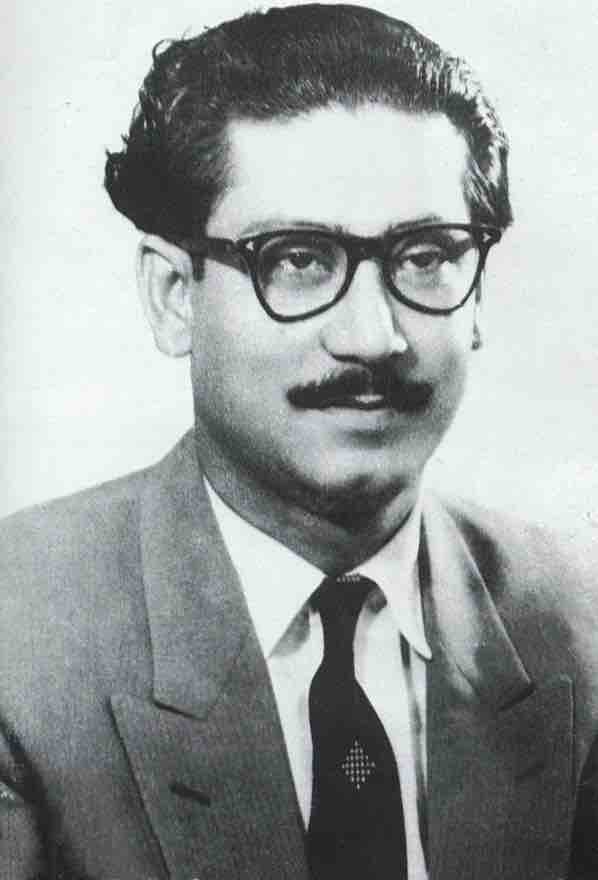
Image Source – Wikipedia
On the other hand, the Indian National Congress (INC) came back to power with a huge majority in 1971 Lok Sabha elections. Indira Gandhi became the Prime Minister for the second time.
The Start of the Carnage – The seeds sown for the Bangladesh Liberation War
Just when Sheikh Mujib-ur Rehman staked his claim to form the government, both Yahya Khan and Zulfikar Ali Bhutto (leader of the People’s Party of Pakistan – PPP) joined hands to restrain Awami League from coming to power. People in East Pakistan were certainly not happy. The leaders of West Pakistan sniffed that victory of the Awami League meant an authority shift from the West to the East. A more radical outcome, they thought, could be the liberation of East Pakistan. The people of East Pakistan wanted a new and separate country (now known as Bangladesh), which of course, West Pakistan didn’t want.
To suppress the voices, in March 1971, thousands of Yahya’s troops from West Pakistan entered East Pakistan and began their assault. The operation was called Operation Searchlight. No one was spared, not even children. Hindus and Muslims got the same treatment. Writers, artists, philosophers, and student leaders were killed mercilessly. Yahya ensured that Sheikh Mujib-ur Rehman was arrested and taken to West Pakistan while his army stood its ground wreaking havoc.
Media Censorship and Estimates
Media censorship in place, information about killings, torture, and rapes in West Pakistan still leaked. The news entered every country around the globe. Some experts even termed the assault as genocide.
As per the US estimates, the causalities in East Pakistan were between 50,000 to 3 million during the massacre.
Refugees in West Bengal
It was imminent and that is what exactly happened. Lakhs of people fled East Pakistan and entered West Bengal (a state in India) to seek refuge. The elderly, women, children, and even the leaders of the Awami League fled. It was a mass exodus.
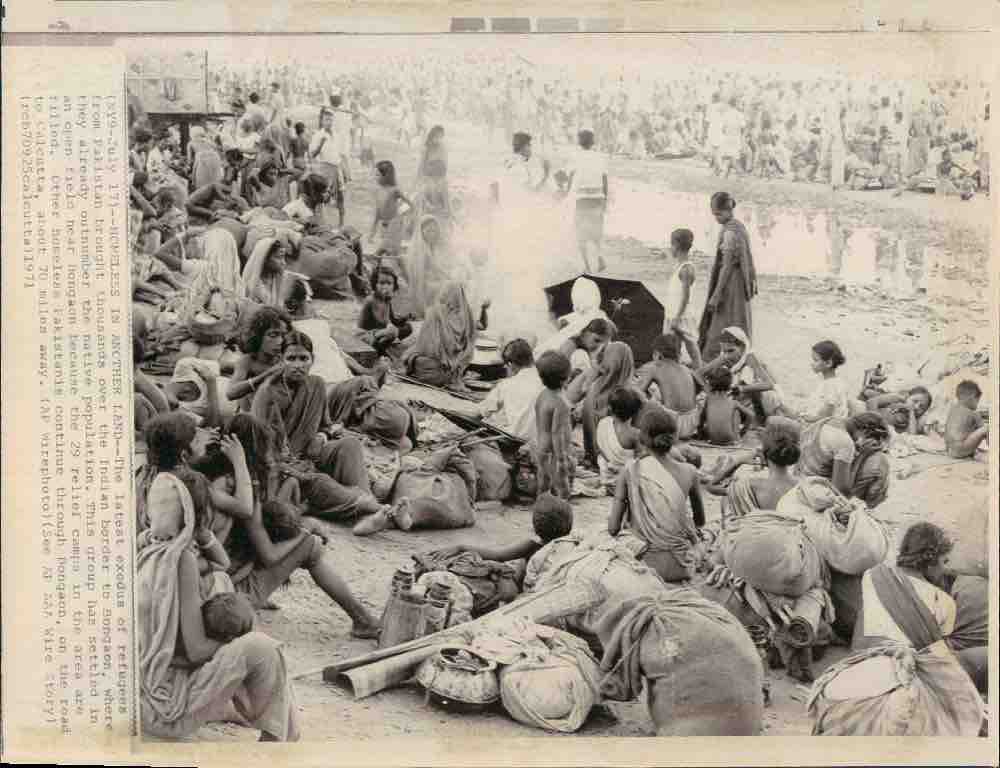
Image Source – OldIndianPhotos.in
Indira Gandhi knew that any escalation of this problem could lead to war between India and Pakistan. She knew that the integrity and security of India were the highest priority, and soon a call had to be taken on the refugee situation. She was ready for the Bangladesh Liberation War if the situation granted that.
Monsoons Nearby – Delay in the Bangladesh Liberation War from the Indian side
Indira Gandhi was proactive. She needed clarity on the consequences if India prepared for the war with Pakistan. She was also aware that there was no probability of talks between the two Pakistan territories.
On 25 April 1971, Indira Gandhi summoned the Commander-in-Chief (Chief of the Army Staff) of the Indian Army, S.H.F.J. Manekshaw to assess the situation. Just a few days back, she had received letters from the Chief Ministers of Assam, West Bengal, and Manipur about the criticality of the refugee problem. Indira Gandhi was clear. If war was the need of the hour, she would have it. But, Manekshaw was prudent. He told Indira Gandhi to not take any rash decisions.
Manekshaw knew that the Monsoon was around the corner and that it was a major challenge. Any action against West Pakistan on the soil of East Pakistan during that time wouldn’t be successful. There was a high probability of floods. He also apprised the Prime Minister that he will have to create a strategy, assemble the troops, and prepare them for the war. It was not possible overnight. Famine was another major issue that concerned Manekshaw. If India went to war during the harvest season, there could be issues with the transportation of food leading to famine.
Chief of Army Staff (COAS), Sam Manekshaw, was ready to resign if Indira Gandhi pushed him to go to war against his opinion. He promised Indira Gandhi victory if the war would be be fought on his terms. After the discussion, Indira Gandhi and General Maneshaw were on the same page. She took a step back for the time being.
Moving Forward
After the discussion, both Indira Gandhi and COAS Manekshaw worked closely together. Indira went to refugee camps in every state concerned. There were millions of them and of every religion. The attack by West Pakistan did not target a particular community. It was to suppress the voices for democratic rights and a new country.
Indira Gandhi did all she could to highlight the situation in East Pakistan and India to the world. When she delivered a speech in Lok Sabha relating to the refugee situation, there was a single voice for the security of the country. Everyone backed the Prime Minister but also urged her to take immediate action. She did not endorse the idea of the Bangladesh Liberation War then as per discussion with COAS.
President Nixon and the United States
The then-president of the United States, Richard Nixon, had a strong dislike for Indira Gandhi and India. This was because Nixon thought that India had affinity towards Kennedy’s ideology.
The rough relationship indicated that the US would never back India if the war happened. Nixon also knew of the friendship of India with the Soviet Union and it made him uneasy. Another reason for Nixon backing Pakistan was the fact that Pakistan acted as a middleman to soften relations between the US and China.
The media targeted Nixon for his inclination and soft attitude towards Pakistan. Though he didn’t come out explicitly stating he supported Pakistan, his actions were obvious. The world knew what was happening in East Pakistan and everyone took a stand against Yahya Khan’s brutality.
Henry Kissinger (National Security Advisor to President Nixon) later supposedly told L.K. Jha, the Indian Ambassador to the US to send the message to Indira Gandhi that the US is going to shake hands with China, and if India opposed the move, they may take drastic steps.
Support from across the world
East Pakistan received support from across the world. The guerrilla fighters of East Pakistan, members of Mukti Bahini, took up arms to stop the assault by Yahya’s men. Andre Malraux, who took part in the Spanish Civil War in the 1930s offered help to Mukti Bahini by taking up arms. A huge concert of Sitar Maestro Pandit Ravi Shankar and George Harrison (Beatles) was organized to raise funds for refugee relief camps.
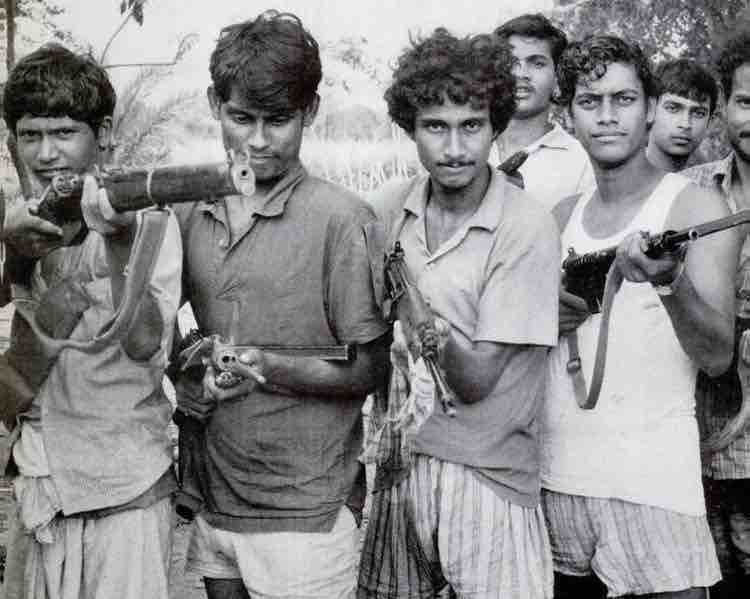
Image Source – Alchetron.com
Popular freedom fighter of India, J.P. Narayan, visited countries and apprised the people about the state of East Pakistan. He even urged Indira Gandhi to take immediate action against what was happening in the neighboring region. Indira made no commitment.
Jayaprakash Narayan also organized a world conference in New Delhi to showcase the torture and killing of people in East Pakistan. Indian National Congress boycotted the conference because it did not want to tag itself to a particular ideology.
Deluge and trial of Mujib-ur Rehman
As predicted by COAS Manekshaw, during the monsoons, the relief camps were in bad condition. There were floods and marshes. People were starving. The roads had become inaccessible due to bad weather conditions.
In the midst of it, Indira Gandhi got the news that the military trial of Sheikh Mujib-ur Rehman was in the process without giving him any legal guidance.
Meeting with Soviet
As the US showed its intention, Indira Gandhi turned to the Soviet Union. A treaty of Peace, Friendship, and Co-operation was signed between India and the Soviet Union. President Nixon went paranoid thinking that the Soviets will help India in the Bangladesh Liberation war and may also attack West Pakistan.
Indira Gandhi visited Moscow in September of 1971 and had talks with President Aleksei Kosygin. They both were on the same page about the refugee situation and the burden on India due to the refugee influx.
The Naxalites
One of the other challenges for Indira Gandhi was the interference of Naxalites who had been creating problems in India since 1967. By September 1971, there were over 10 million refugees in India from East Pakistan.
Indira Gandhi had information from the secret services that Naxalites could take advantage of the refugee situation and might begin an internal war. There was news that Naxalites had started interfering in the work of relief camps and that they were assaulting the volunteers. Rumors stated that the Naxalites wanted to force the refugees into Calcutta (now Kolkata) to create unrest and instability.
Build up to Bangladesh Liberation War – The Retaliation
By the end of August or early September in 1971, the East Pakistan forces and Mukti Bahini were ready to launch attacks on the West Pakistan army which had invaded their territory. They were ready for the inevitable Bangladesh liberation war.
The guerilla fighters traveled to the ports of Chittagong and Jalna and deployed mines. On paper, about fifty thousand tonnes of West Pakistan navy shipment was destroyed. The attack handicapped West Pakistan at least in transferring the war equipment to and fro via sea.
Mukti Bahini also created secret cells in many areas. This gave Mukti Bahini an advantage as they were able to organize attacks on Yahya’s army from various locations.
According to reports, such retaliation by East Pakistan caused fear in the mind of Yahya Khan. He sorted the help of the US to act immediately. He wanted the US to urge the United Nations to send observers to keep a watch on both sides of the border between India and East Pakistan. The idea was to stop Mukti Bahini from conducting any major operation against his army.
Trip to Europe & the United States
In the wake of devastation and instability, Indira Gandhi visited major cities around Europe and held talks with the leaders and the country heads. She was clear in showcasing what was the ground situation in India and in East Pakistan. The leaders of Europe sympathized with Indira Gandhi and India but didn’t take a stand against Pakistan. All the countries wanted the same thing that Yahya Khan wanted i.e. United Nations observers to be deployed.
Indira Gandhi did not back down even when there was no support from any country. She knew that only peace talks between West Pakistan and Sheikh Mujib-ur Rehman were the solution to ease the situation. However, she also knew that such a thing will never happen. She had to protect India and its borders. Deploying U.N. observers will not solve anything. The massacre and the situation will not diffuse.
After her trip to Europe, Indira Gandhi identified that a meeting with President Nixon would be a good idea. As expected, the meeting turned out to be a disaster. President Nixon and Indira Gandhi were both hostile and never came to a common understanding.
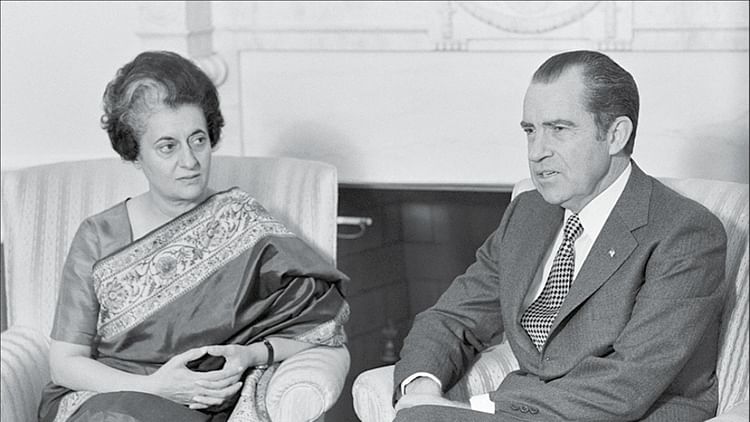
Image Source- NationalHeraldIndia.com
The Bangladesh Liberation War
On 4 December 1971, Indira Gandhi after talks with COAS Manekshaw gave orders to launch attacks on the West Pakistan army to liberate East Pakistan. The decision came after Yahya Khan supposedly ordered its Air force to attack some of the Indian Airbases.
There was a point in time during the war when it looked like the Indian Army was bogged down due to the weather conditions. Indira Gandhi was nervous but patient. The Chief of Army Staff, Sam Manekshaw, took over the situation and ensured that the Indian Army proceeded with all guns blazing.
With the positive signal from Manekshaw, Indira was confident of the win. She made sure her voice was heard in the Parliament relating to the liberation of Bangladesh and in accepting Sheikh Mujib-ur Rehman as its leader. She had massive support, even from the opposition parties.
The Indian Army proved to be too strong for Yahya’s men. The result was that within a week after the Indian Army entered the war, the West Pakistan army was ready to surrender.
Final action by the United States
President Richard Nixon never wanted West Pakistan to lay down its arms and surrender. He was paranoid and obsessed with the thought that India had the support of the Soviets and that they would liberate Bangladesh, then launch an attack on West Pakistan, and might even free Pakistan Occupied Kashmir (PoK). Nixon also expected that China would enter the war being on West Pakistan’s side and that the US would aid them. But, nothing of that sort happened.
However, Nixon was still adamant to help and stop the surrender of West Pakistan troops. He ordered Seventh Fleet to move from Sulva Bay in the Philippines to the Bay of Bengal.
L.K. Jha, the Indian Ambassador to America after getting information of the fleet movement felt that it was being done to evacuate the top West Pakistan army officers. He was not at all happy with the situation and had the impression that the US would remain neutral on the issue. Jha even went ahead with a press conference where he talked about the Seventh Fleet and that created unrest within the media.
Indira Gandhi’s Take
In India, Indira Gandhi was on high alert when she heard the news about Seventh Fleet closing in. She held talks with Naval officers and advisers. She wanted to be sure of what would be the course of action if the US interferes in the proceedings. The advisers were not inclined toward the perception that the US Navy would invade East Pakistan and enter the war. The US was already part of the war in Vietnam. However, they did not deny that the US could evacuate top West Pakistan officers from East Pakistan.
The Indian Army was given orders to keep a check on the port cities of Chittagong and Khulna to counter any action from the Seventh Fleet.
When the news of the Seventh Fleet closing in broke in the media on 12 December 1971, Indira Gandhi gave a speech in the Parliament in which she promised that the Indian Army will not retreat from its position. There was widespread anger in India against the US for what they were doing. Nixon was accused by his own media of creating false agendas relating to India and the Soviets.
End of Bangladesh Liberation War – The Surrender
India declared war on Pakistan on 4 December 1971 after it launched attacks on India. On 16 December 1971, the war ended when General A.A.K Niazi, commander of the West Pakistan army in East Pakistan, surrendered in Dhaka in the presence of Lieutenant General Jagjit Singh Aurora of the Indian Army. The war concluded before the Seventh Fleet could reach the ports of East Pakistan. There were approximately 93,000 Pakistani prisoners of War (PoW) when the war ended, though they were later released by India.
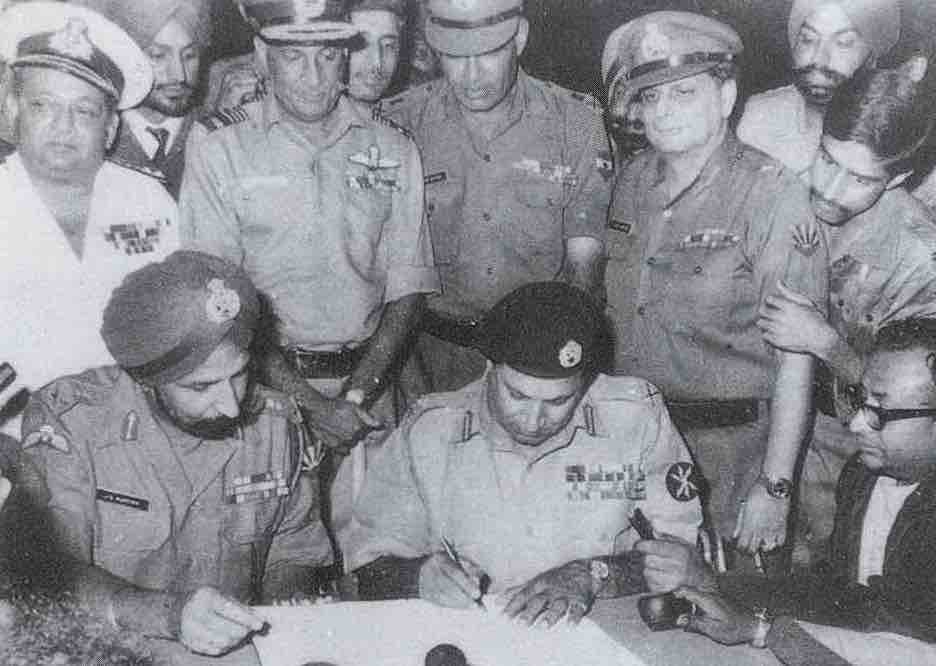
Image Source – indiannavy.nic.in
COAS Sam Manekshaw broke the news to Indira Gandhi, after which she spoke in Lok Sabha and apprised the house about West Pakistan’s surrender and the liberation of Bangladesh. The moment was historic. She referred Sheikh Mujib-ur Rehman as the father of Bangladesh.
Indira Gandhi was praised for the victory. Everyone in the house gave a standing ovation. But, there was an uncertainty looming. Indira Gandhi was urged by the opposition and people to carry out attack on West Pakistan that was still reeling from the loss. She took stock of the situation but was not committed to making any rash decisions.
As per the army chiefs and the advisers, invading cities in West Pakistan meant a high number of casualties. Everybody wanted an attack on West Pakistan. The Prime Miniter did not give in to her emotions. She knew that if a step to launch attacks on Pakistan was taken by India, it could lead to chaos and the world powers might end up locking horns. She was not in favor of this and thus rejected the voices. A ceasefire was called upon.
Bangladesh Liberation War – The Conclusion
On 17 December 1971, Indira Gandhi gave a speech in Parliament praising the Indian forces and Mukti Bahini. She spoke of Pakistan and that India will not interfere or take any further action against them.
On the other hand, Yahya Khan resigned from the post of Presidentship and Zulfikar Ali Bhutto took over as the Prime Minister of Pakistan. Released in January 1972, Sheikh Mujib-ur Rehman took over the charge as the first President of Bangladesh.
The Indian Republic Day celebrations of 1972 were a spectacle. The crowd and everyone appreciated what Indira Gandhi did in the crisis and how she and the Army enabled the freedom of Bangladesh. Praised for her unwavering stance against President Nixon and his policies, the Indians tagged Indira Gandhi as “Durga”, a fearless deity in Hindusim.
Good Reads & References
- Indira Gandhi – A Biography by Pupul Jayakar
- Bangladesh Liberation War – Wikipedia
- Recalling December 15, 1971 – the day before Pakistan surrendered – Scroll.in
CURATED & WRITTEN BY
AYUSH PANDYA
(AUTHOR – THE UNPRECEDENTED CULT)